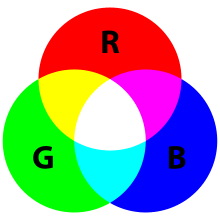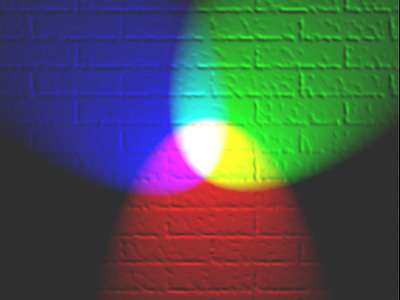Additive color


Additive color is a method to create color by mixing a number of different light colors, with shades of red, green, and blue being the most common primary colors used in additive color system.
Additive color is in contrast to subtractive color, in which colors are created by subtracting (absorbing) parts of the spectrum of light present in ordinary white light, by means of colored pigments or dyes, such as those in paints, inks, and the three dye layers in typical color photographs on film.
The combination of two of the standard three additive primary colors in equal proportions produces an additive secondary color—cyan, magenta or yellow—which, in the form of dyes or pigments, are the standard primary colors in subtractive color systems. The subtractive system using primaries that are the secondaries of the additive system can be viewed as an alternative approach to reproducing a wide range of colors by controlling the relative amounts of red, green, and blue light that reach the eye.
Computer monitors and televisions are the most common examples of additive color. Examination with a sufficiently powerful magnifying lens will reveal that each pixel in CRT, LCD and most other types of color video displays is composed of red, green and blue sub-pixels, the light from which combines in various proportions to produce all the other colors as well as white and shades of gray. The colored sub-pixels do not overlap on the screen, but when viewed from a normal distance they overlap and blend on the eye's retina, producing the same result as external superimposition.
Another example of additive color can be found in the overlapping projected colored lights often used in theatrical lighting for plays, concerts, circus shows and night clubs.[1]
The full gamut of color available in any additive color system is defined by all the possible combinations of all the possible luminosities of each primary color in that system. In chromaticity space, the gamut is a plane convex polygon with corners at the primaries. For three primaries, it is a triangle.
Results obtained when mixing additive colors are often counterintuitive for people accustomed to the subtractive color system of pigments, dyes, inks and other substances that present color to the eye by reflection rather than emission. For example, in subtractive color systems, green is a combination of yellow and cyan; in additive color, red plus green makes yellow. Additive color is a result of the way the eye detects color, and is not a property of light. There is a vast difference between a pure spectral yellow light, with a wavelength of approximately 580 nm, and a mixture of red and green light. However, both stimulate our eyes in a similar manner, so we do not detect that difference, and both are yellow light to the human eye. (See eye (cytology), color vision.)
History

Systems of additive color are motivated by the Young–Helmholtz theory of trichromatic color vision, which was articulated around 1850 by Hermann von Helmholtz, based on earlier work by Thomas Young. For his experimental work on the subject, James Clerk Maxwell is sometimes credited as being the father of additive color.[2] He had the photographer Thomas Sutton photograph a tartan ribbon on black-and-white film three times, first with a red, then green, then blue color filter over the lens. The three black-and-white images were developed and then projected onto a screen with three different projectors, each equipped with the corresponding red, green, or blue color filter used to take its image. When brought into alignment, the three images (a black-and-red image, a black-and-green image and a black-and-blue image) formed a full color image, thus demonstrating the principles of additive color.[3]
Examples



The following chart demonstrates an example of the mixing and perception of additive primaries, step by step.
| Light source | Green (medium wavelength) light and red (long wavelength) light radiate from two different projectors. |
| Projection screen | Both the green and the red light reflect off of a spot on the screen. |
| Retina | The mixed light activates the M and L cones on a spot on the retina about equally. |
| Brain | The brain interprets the equal amounts of M and L signal as yellow. |
To fully understand the process, it should be demonstrated how dull colors are obtained using cyan, magenta, and yellow instead of red, green, and blue.
| Light source | Cyan (short to medium wavelengths) and yellow (medium to long wavelengths) light radiate from two different projectors. |
| Projection screen | Both the cyan and yellow reflect off of a spot on the screen. |
| Retina | M cones on a spot on the retina are strongly activated by both the cyan and yellow light, while S cones are activated by cyan and L cones by yellow. |
| Brain | The brain receives signals from the cones about some short, lots of medium, and some long wavelengths. It interprets the signal as pale (unsaturated) green. |
See also
References
- ↑ David Briggs (2007). "The Dimensions of Color". Archived from the original on 2015-09-28. Retrieved 2011-11-23.
- ↑ "James Clerk Maxwell". Inventor's Hall of Fame, Rochester Institute of Technology Center for Imaging Science. Archived from the original on 2010-09-18.
- ↑ Robert Hirsch (2004). Exploring Colour Photography: A Complete Guide. Laurence King Publishing. ISBN 1-85669-420-8. Archived from the original on 2017-02-25.
External links
- RGB and CMYK Colour systems.
- http://www.edinphoto.org.uk/1_P/1_photographers_maxwell.htm - Photos and stories from the James Clerk Maxwell Foundation.
- Stanford University CS 178 interactive Flash demo comparing additive and subtractive color mixing.
